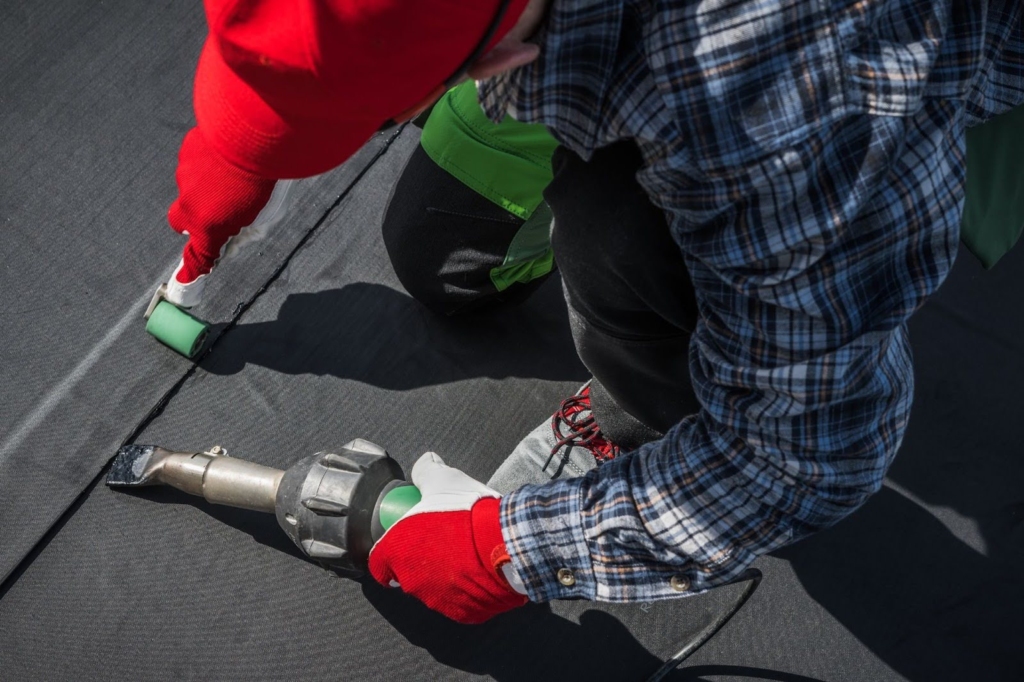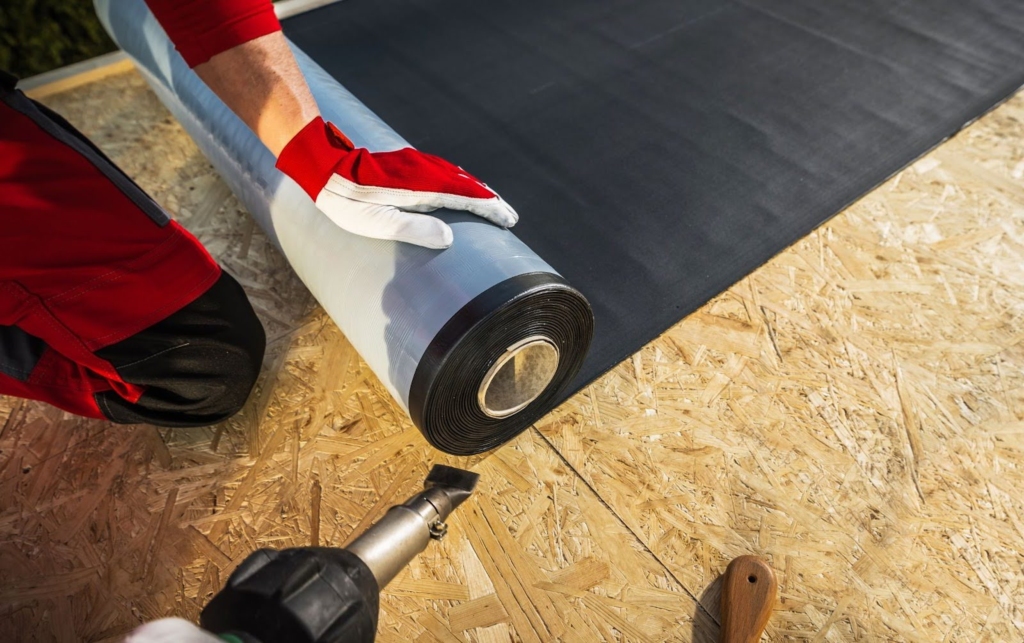A roof isn’t just a surface; it’s your building’s first defense. Choosing the wrong material can lead to leaks, insulation loss, and costly repairs. Due to its flexibility and lifespan, EPDM roofing has become a popular choice for flat and low-slope buildings. Before making that decision, it’s essential to understand what it offers and where it may fall short.
What is an EPDM Roof System?
An EPDM roof is a rubber membrane system for low-slope or flat roofs. It’s made from a synthetic rubber compound called ethylene propylene diene monomer. EPDM offers strength, flexibility, and resistance to weather extremes, making it an ideal choice for both commercial and residential applications. Most systems are available in black or white and are installed in large rolls to minimize seams.
How EPDM Roofs Are Made and Installed
EPDM membranes are manufactured using a mix of oil-based and natural gas byproducts. These materials create a firm, weather-resistant surface that stretches without tearing. Installation methods include full adhesion, mechanical fastening, or ballasting. Each technique depends on the roof structure, climate, and client preference. Proper installation ensures fewer leak points and stronger long-term performance. Most systems can be installed in a single layer with minimal disruption to the property.
Common Applications of EPDM Roofs
EPDM roofs are widely used in warehouses, retail plazas, garages, and office buildings. They’re also used on homes with modern architecture and flat roofing designs. Because the material can be laid in large sheets, it efficiently covers wide surfaces. EPDM’s resistance to sun, snow, and wind makes it ideal for areas with harsh weather swings. It’s also lightweight, making it suitable for older structures needing a roof upgrade. Property owners often choose it when longevity and affordability are key considerations.
Key Advantages of an EPDM Roof
EPDM roofing offers durability, ease of installation, and cost savings. It’s one of the most practical solutions for flat roofs, striking a balance between performance and low maintenance. While it doesn’t work for every building type, its advantages are hard to overlook. These strengths position EPDM as a leading choice in roofing projects, often outperforming traditional systems in terms of durability and cost efficiency.
Long-Lasting and Weather-Resistant Roofing
EPDM roofing systems are known for their long service life. Proper installation and upkeep can last 25 to 30 years or longer. The rubber membrane resists damage from hail, UV rays, and snow. It remains flexible in cold temperatures and doesn’t crack easily in the heat. This durability makes it ideal for regions with seasonal extremes. Commercial property owners especially benefit from the reduced need for frequent replacements.
Easy Installation Reduces Labor Time
Installing an EPDM roof typically takes less time than installing most other roofing systems. The material comes in large rolls that cover vast areas quickly. Fewer seams mean fewer weak points and faster job completion. Most roofing contractors can install EPDM with basic tools and adhesives, reducing labor costs and scheduling delays. It’s a strong choice for time-sensitive projects or budget-limited jobs.
Energy Efficiency for Climate Control
EPDM roofs support energy savings year-round. Black membranes absorb heat, helping lower heating costs in winter. White membranes reflect sunlight, which reduces cooling needs in hot climates. This adaptability helps property owners select the version that matches their local weather patterns. EPDM also insulates against air loss and moisture infiltration. That translates into fewer HVAC demands and lower utility bills.
Budget-Friendly Roofing Materials
EPDM is more affordable than metal, TPO, and PVC roofing systems. Its raw materials and simple manufacturing make it cost-effective. Because it requires fewer materials during installation, the total cost stays low, making it accessible for commercial projects and residential retrofits. Maintenance expenses also remain modest over time. For buildings with large roof surfaces, these savings can be substantial.

Minimal Maintenance Requirements
EPDM roofs require little maintenance once installed. Routine inspections and occasional surface cleaning are usually enough. Minor issues, such as small tears, can be easily patched with rubber tape or sealant. The membrane doesn’t attract algae or mold, reducing cleaning needs. Seam checks, performed once a year, help prevent adhesive wear. This low-effort upkeep appeals to building owners with limited maintenance staff or budgets.
EPDM Roof Drawbacks to Consider
Despite its strengths, EPDM is not without flaws. Like any roofing material, it performs best in the proper context. Owners should weigh appearance, installation risks, and environmental fit. Awareness of these challenges leads to better planning and fewer regrets.
Limited Color and Design Variety
EPDM roofs offer little in terms of aesthetics. The material is primarily black, with white available for reflective versions. There are no texture options, and color choices are minimal. EPDM can clash with specific architectural styles or visual goals. It may not deliver the desired curb appeal for buildings with a visible roof. In such cases, more decorative roofing options may be preferable.
Prone to Shrinking and Tearing
Over time, EPDM membranes can shrink slightly, especially in high-heat areas. This shrinkage can cause the membrane to retract from seams, vents, or flashing, creating gaps that may lead to leaks. The material also tears more easily if heavy objects or sharp tools contact the surface. Foot traffic can create wear spots if not managed carefully. Frequent rooftop use may require protective pavers or walk pads. Regular inspections help catch shrinkage and damage before they lead to leaks.
Seams and Adhesives Can Break Down
Even though EPDM is installed with large rolls, seams still exist. These connection points rely on glue, tape, or mechanical fasteners. Harsh weather, poor adhesion, or aging can cause these bonds to fail. Seams are typically the first part of the roof to show wear. Repairs are simple but require attention and timing. Hiring a skilled installer reduces the risk of adhesive failure from the start.
Not Suited for Steep-Slope Roofs
EPDM roofing performs best on flat or low-slope roofs. The membrane may wrinkle or shift out of place when applied to steep pitches. Water runs off too quickly, straining seams and edges. The visual result can also appear unfinished or out of place. Asphalt shingles or metal systems perform better and look more polished in these cases. Knowing your roof slope is crucial before selecting EPDM.

EPDM vs. Other Common Roofing Systems
Choosing the right roofing system involves comparing performance, price, and appearance. EPDM holds up well against newer systems, such as TPO and PVC, as well as older ones, like asphalt. Each has strengths and ideal use cases. Understanding these differences helps owners make informed decisions.
Comparing EPDM to TPO and PVC Membranes
TPO (thermoplastic olefin) and PVC (polyvinyl chloride) roofs also use single-ply membranes. TPO reflects sunlight better, making it more popular in hot climates. PVC handles chemical exposure well, making it ideal for use in restaurants or laboratories. EPDM offers better flexibility and cold-weather resistance than both. It also costs less upfront and requires less technical installation. The right choice often depends on the climate and the building’s purpose.
EPDM vs. Asphalt Shingle Roofing
Asphalt shingles dominate steep-slope residential homes. They offer more style, texture, and color options than EPDM. However, shingles wear faster in extreme temperatures and don’t suit flat surfaces. EPDM outperforms asphalt on flat or low-pitched roofs, particularly in areas with limited drainage. It’s also easier to repair and lasts longer in commercial settings. Property owners should consider the roof angle and durability needs before making a choice.
Deciding If EPDM Fits Your Roofing Project
EPDM isn’t a one-size-fits-all solution, but serves many building types well. Whether you’re managing a commercial retrofit or a home renovation, it brings long-term value. To make the best call, consider the roof shape, weather conditions, and the building’s intended use. Matching the roof to these factors delivers better results.
Residential vs. Commercial Roof Applications
EPDM is more commonly used in commercial buildings, such as offices, warehouses, and hospitals. These structures typically feature flat or low-sloped roofs, which EPDM is well-suited to handle. Some modern homes also use EPDM for flat roof designs or additions. Its plain look may not suit all homes, but it excels in performance. For garages, sunrooms, or porches, it’s a wise choice. Mixed-material roofing may offer the best design and function in residential cases.
Roof Suitability Based on Regional Weather
Your local climate should always be taken into account when making roofing choices. EPDM withstands snow, hail, and freezing temperatures in colder climates. In warm regions, white EPDM reflects heat, helping to keep buildings cool. Over time, extreme heat may still cause shrinkage or adhesive breakdown. Choosing membrane color and thickness based on weather improves performance. Local contractors often recommend options based on tested results in your region.
Budget Planning for Long-Term Roof Costs
EPDM offers a low upfront price with fewer maintenance expenses, making it attractive for projects with long-term goals. While it may lack decorative appeal, it outperforms many systems in function. If installation is done correctly, unexpected repairs are rare. Always budget for annual inspections and occasional patching. These minor costs help avoid full replacements or significant leak damage.
Secure Long-Term Value With an EPDM Roof
Waiting for roof damage to force a decision costs more than acting with intention. EPDM roofing offers reliability without the guesswork, especially for flat or low-slope properties that demand performance over flair. If you’re weighing cost, durability, and ease of upkeep, this solution checks every box. Now’s the moment to stop patching problems and start building lasting protection.
Want to make better roofing choices? Visit the NorthCoast Roofing Inc. blog for practical advice and real-world solutions.

